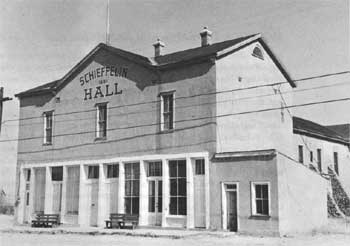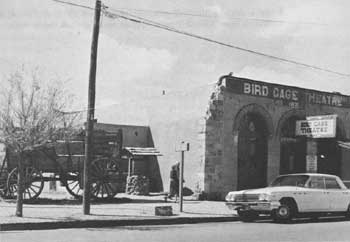






Survey of Historic Sites and Buildings
 |
TOMBSTONE Arizona |
 |
| ||
Ownership and Administration. Various private owners; and State of Arizona, State Parks Board.
Significance. In the summer of 1877 soldiers at nearby Fort Huachuca advised prospector Ed Schieffelin that all he would find would be his "tombstone," not the rich mineral deposits he sought. Because of hostile Apaches in the vicinity the advice seemed sound. But Schieffelin persisted in his search and found a silver bonanza, which attracted droves of miners, gamblers, gunmen, and others. By 1881 Tombstone was a booming town of 7,000 people. When Wyatt Earp served as a lawman there in the early 1880's, the famous Earp-Clanton feud made the town a battleground of warring factions and culminated in the celebrated fight at the O. K. Corral. Later, rancher John Slaughter became sheriff and made progress in cleaning up the town.
 |
| Tombstone, Arizona, was the site of one of the great silver bonanzas. Ed Schieffelin constructed this hall with the proceeds from his fabulous strike. |
In the mid-1880"s water began to fill the mining shafts. The expensive pumping equipment that was imported failed to solve the problem. By 1888 mining was at a virtual standstill, and by 1890 the town was well on the way to oblivion. In 1914 the Phelps-Dodge company took over the mining properties and still mines some ore. The total value of the silver taken from the vicinity of Ed Schieffelin's "tombstone" is estimated at approximately $80 million.
Present Appearance. Tombstone has advertised itself as "The Town Too Tough to Die," and indeed it is. Except for the addition of some neon signs and paved streets, it retains much of its frontier flavor—and is recapturing even more. Among the more important buildings still standing from Territorial days are the Bird Cage Theatre, the Tombstone City Hall, the Cochise County Courthouse, Schieffelin Hall, the office of the Tombstone Epitaph, and St. Paul's Episcopal Church. Boot Hill Cemetery is another attraction; the grave markers are periodically refurbished. Recently the Tombstone Historic Associates, a private group, renovated Schieffelin Hall and provided a number of other visitor attractions.
 |
| Tombstone retains much of its frontier flavor. The Bird Cage Theatre is one of the many Territorial buildings still standing. |
In 1957 a group of local citizens formed the Tombstone Restoration Commission and began gathering material to establish a museum in the old Cochise County Courthouse. Two years later, the State took over the courthouse and designated it as a State park. The courthouse contains authentic period furniture, weapons, mining machinery, assayers' equipment, photographs, and documents relating to the famous Earp family. [3]
NHL Designation: 07/04/61
 |
 |
http://www.cr.nps.gov/history/online_books/prospector-cowhand-sodbuster/sitec1.htm
Last Updated: 22-May-2005